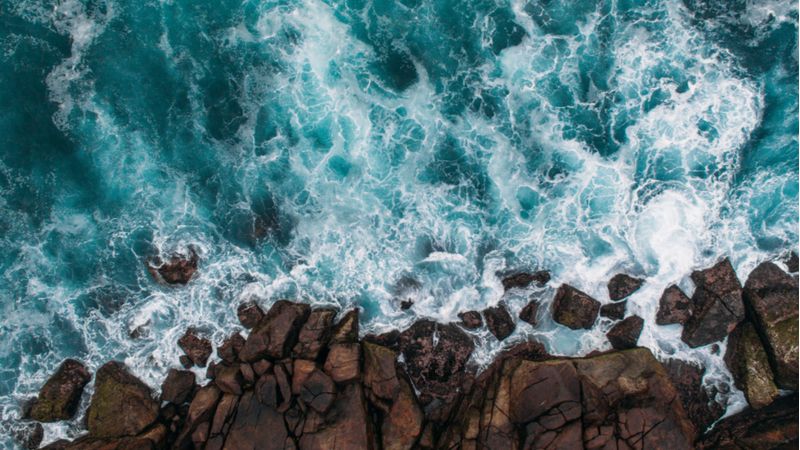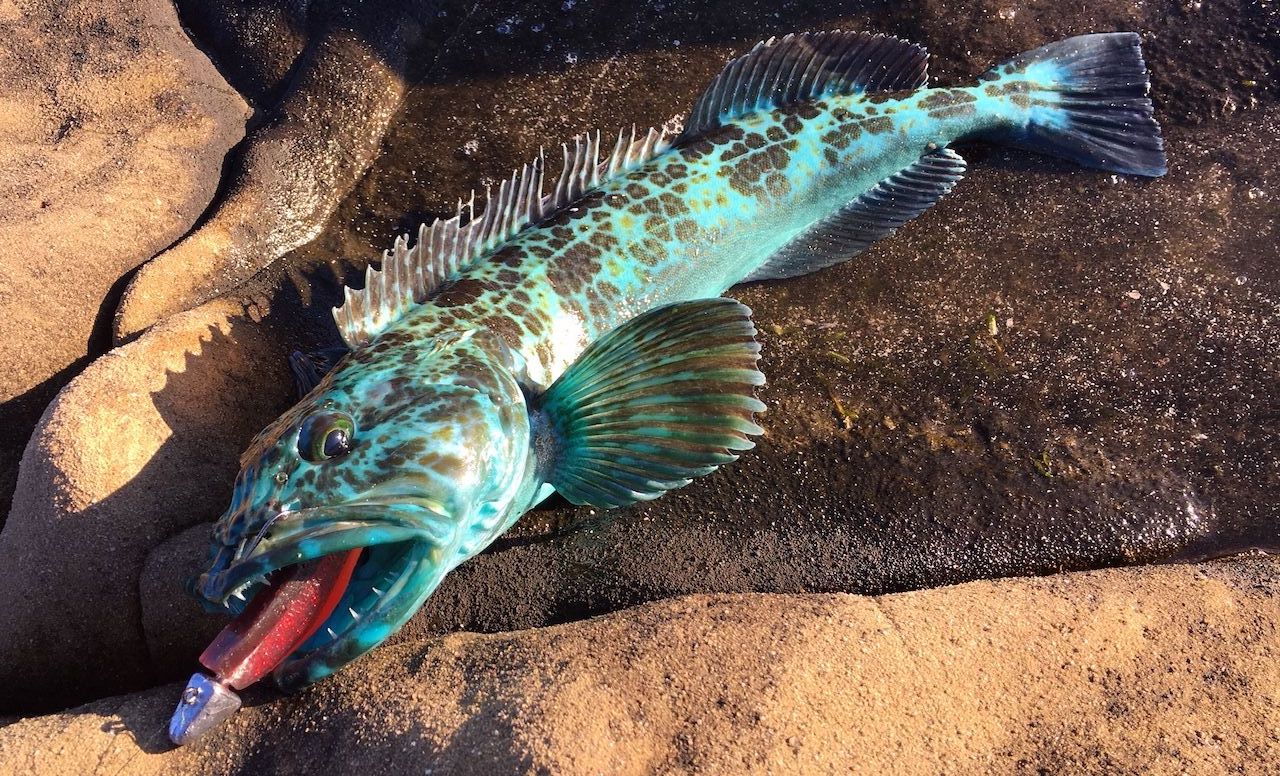
Your resource for Sonoma County fishing information

Fishing for lingcod from shore, without using bait, is a challenging and rewarding method of fishing. It requires patience, determination and the willingness to put out a lot of effort, usually just to catch one fish.
Before even heading out to the coast, you need to monitor the forecasts, sometimes for weeks, while you wait for the perfect conditions. Once the conditions are right and you’re driving on the Pacific Coast Highway, you’ll need to choose your fishing spots wisely to increase your odds of catching a legal-sized fish. You’ll also need the right gear in order to catch lingcod on a consistent basis without arm fatigue. I’ll cover all of these topics in this guide in order to arm you with the knowledge you need to catch a keeper lingcod from shore.

The number one rule when it comes to shore fishing for lingcod is to wait for the right day. You want to look for the perfect set of conditions in order to give yourself the best chance possible at landing a legal-size fish. In general, the fishing conditions are usually good between 2 and 5 times a month. Having said that, there have been times where I have checked the forecasts consistently for 2 months and didn’t find a single day that I would consider fishable. It’s hard enough already to catch lingcod from shore so remember to be patient and wait for the right conditions: low swell, low wind & high tide.
Tip: Use Magic Seaweed to forecast the swells and the wind!
When forecasting, you want to look for swells that are 5 ft or less in height and generally coming in at a frequency of 14 seconds or under. Fishing with low swell is great for a few reasons: your lure stays near the bottom for longer using less weight, you snag up less often, it’s safer to rockhop, and it’s easier to land big fish without powerful swells making things complicated. If you do decide to fish during a large swell day, pay special attention to the swell direction and look for a fishing spot that is facing away from the swell.
The ideal wind lies somewhere between no wind at all and an 8 mph offshore wind. Onshore wind hurts your casting distance and helps increase the size of the existing swell. Offshore wind, on the other hand, can help your casting distance but can also cause the waves to become steeper than normal and break with more force. As a rule of thumb, I look for days with an onshore wind speed of 8 mph or under, or an offshore wind speed of 12 mph or under. Most of the time, you need to be casting 40-60+ yards out to have a good chance at a fish; you don’t want an onshore wind making those long casts more difficult than they already are.
Unlike swell and wind, tide is not a “make or break” issue when it comes to fishing from the rocks. Rockfishing can be productive during any tide but I typically prefer to start fishing midway up a high tide.
High tide increases the water depth at every fishing spot so you can typically fish each cast for a longer period of time. The deep spots become even deeper so you can jig higher and let the lure fall for a longer period of time. Also, the spots that are normally too shallow to fish due to snags become fishable and productive.
Low tide, on the other hand, allows you to rock-hop to spots that would otherwise be inaccessible during high tide. When rock-hopping, always remain aware of the tidal movement and don’t risk getting stranded. If you don’t feel comfortable rock-hopping or if you are having trouble finding deeper fishing spots along the coast, stick to high tide.
When targeting lingcod from shore, focus on spots that put you within casting range of deep water, rocks and kelp. Lingcod, when close to shore, typically like water 10 feet deep or deeper with a lot of structure. These fish are ambush predators, structure allows them to camouflage and wait for prey to come to them. Anywhere that has rocks, reefs, kelp patties and depth changes is a good place to start fishing. Remember to consider your safety and your ability to land a potentially big fish when choosing a spot. If either of those seem questionable, forget that spot and move on.
In order to catch lingcod and avoid snagging, you need to keep your lure moving around structure. The two ways of retrieving that I've found to be most successful are the "lift and drop" jigging technique and the "slow reel" swimming technique.
The "lift and drop" technique is exactly how it sounds, a combination of lifting the rod and dropping the rod. The advantage of using a jighead-rigged swimbait is that the lure has good action both when you lift the rod tip up and when you let the line go slack. While you lift up the rod, the lure swims up diagonally in the water column, towards you. During the drop, the weight of the jighead causes the lure to swim down towards the bottom. After casting out, let some line out so that your lure can slowly head towards the bottom--sometimes you will even get a strike on the initial fall. After letting the lure fall for several seconds, close the bail and jig up slowly. Repeat this motion, using the reel as little as possible and only to avoid snagging on the bottom.
The "slow reel" technique is also fairly self-explanatory: slowly reel in the swimbait in a manner that keeps it near structure while avoiding unnecessary snags.
While fishing for lingcod, you will want to vary your retrieve in several different ways. For best results, alternate between and combine the above techniques while varying the cadence of your retrieve.
Tip: When fishing a new spot, start off by fishing high in the water column until you discover where the underwater structures are. After you locate the structures, fish deeper and closer to them until you start to snag and then adjust. You need to bring the lure as close to the structure and as deep as possible to catch more fish; this is how you find the optimal depth and location while rockfishing.
In order to cover the water as effectively as possible, you’re going to want a lighter surf rod between 8’6” and 10’ in length. The length is important to get enough distance while casting and a relatively light rod is nice because you’re going to be casting and jigging constantly. Currently, I’m using a Lamiglas Insane Surf, 9’0” MS and can cast it all day without experiencing fatigue. It’s a very thin and light surf rod but has yet to be out-matched by a lingcod. This rod works best with lures in the 2 - 3 oz total weight range and has no problem casting lures 60+ yards which is really impressive considering how light it is.
Choose a saltwater-friendly reel that can withstand the harsh wear and tear. Scrambling on rocks, getting snagged frequently, and reeling in hard-fighting fish can take a toll on your reel. I prefer spinning reels when fishing for lingcods because I don’t want to have to deal with bird-nests of braided line out on the rocks Regardless of whether you use spinning or conventional, choose a reel that’s well built and of good value. When I’m fishing, I use two reels: the Penn Fierce 3000 when throwing smaller plastics a short distance and the Penn Battle 5000 for casting the larger plastics further out. If you want one dedicated lingcod reel, choose one that holds between 150-250 yards of 40 pound braid to cover all your bases.
Braid, braid braid. You absolutely need braid when fishing for rockfish from shore. In order to catch fish regularly, you need your swimbait or lure to be bumping up against rocks and kelp. The braided line helps to free up a lot of the inevitable snags. In addition, a heavy braided line allows you to hoist up most legal-sized fish without risking breaking them off when landing. I like to use 40 pound braid, as I’ve found that diameter strikes a good balance between strength and castability. Even with braid, you have to plan on snagging multiple times each day and retying. Losing tackle is a requirement when rockfishing from shore.
For the best opportunity to catch a lingcod, wait for a calm day at the ocean and try to fish a deep spot on the incoming tide. When selecting gear, choose light but strong gear and expect to lose a lot of tackle to underwater snags because you will need to keep your lures very close to the bottom. Be patient at each fishing spot, pick the spot completely apart before moving on. Remember that it can take several trips before you catch one so keep a positive attitude and enjoy the day, regardless. Good luck out there!